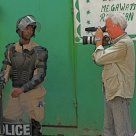It took two months for Adam Keys to regain full consciousness.

“The first thing I remember is the nurse walking out of the room . . . And I asked where I was,” he says.
Before his family moved to Pennsylvania from their home in Nova Scotia teen-aged Adam took a keen interest in the air cadets. Several men in Adam’s family had been in the military men and he decided, from an early age, to follow in their footsteps.
Adam’s mother, Julie, says she knew her son would join the army even before a uniformed recruiter showed up at their door.
At 28, shortly after enlisting, Adam deployed to Afghanistan as an airborne engineer in the US army. His job was working on a team detecting IEDs, improvised explosive devices. It can be a deadly job, and in July of 2009 2010, the vehicle that Adam was riding in struck a 1000-pound mine, his friend and platoon mate was killed, Adam emerged, barely alive.
Adam was airlifted back to the U.S. “His lungs weren’t working, his brain wasn’t working well, his kidneys weren’t working,” says Maryland Trauma Surgeon Dr Sharon Henry, who treated him on his arrival. “He was so sick that he had suffered a cardiopulmonary arrest, several times.” Adam’s heart had stopped five times. Adam regained consciousness but doctors had to amputate his left forearm and both his legs.
Doctors gave Adam a 1% chance of living. A number his mother refused to accept. “One doctor came up to us and said he’s catastrophically ill,” says Julie. “It just – I just knew he would fight for every minute, he wasn’t ready to go.”
Adam Keys not only beat those odds and lived, but he stood up and walked again. But just walking again wasn’t good enough for this soldier. 16×9 was there when he traveled back home to Nova Scotia to walk, for the first time on his own, to his grandparents’ door.
For the full story watch 16×9 Friday at 8 PM – AT/MT, 9 PM – CT, 10 PM – ET/PT.
Two of the stills in “A First Step” were taken by Baltimore-based photographer Coos Hamburger, who was at the R Adams Cowley Shock Trauma Center while Adam Keys underwent treatment. More photographs tracing Keys’ recovery will appear in a future book on trauma, as yet untitled. Hamburger’s website is focophoto.com.




Comments